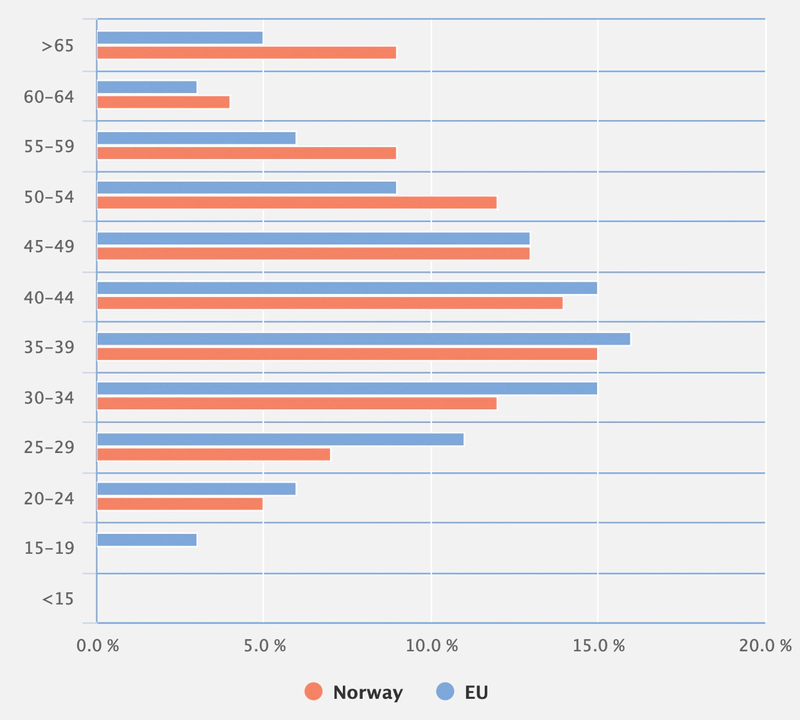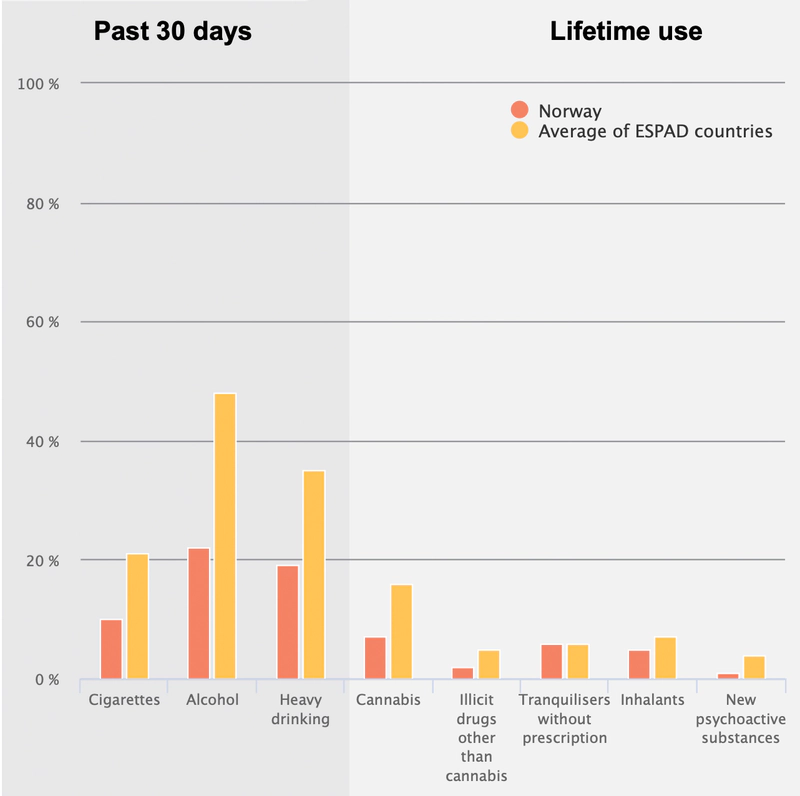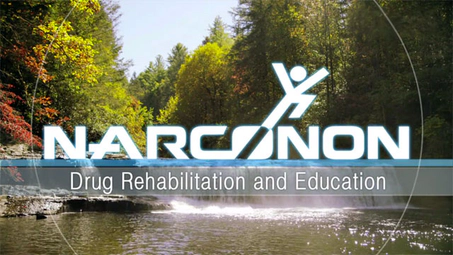Drug Abuse and Losses in Norway

Norway is described as having a high number of drug overdose deaths compared to other EU countries. But even so, the numbers of deaths in countries like the United States and nearby Estonia eclipse Norway’s numbers.1-2 In the US, 21 lives per 100,000 people were lost; in Estonia, 20 lives were lost. In Norway, about nine lives are lost per 100,000 people.3 Still, this is more than twice as much as any other Nordic country.
As is typical in most countries, more than twice as many men die from overdoses as women (in Norway, males suffer 70% of the deaths).4 The total number of lives lost stays below 300 each year, with the peak ages experiencing these losses lying between 35 and 54. The older age ranges – 50 to 54, 55 to 59 and over 65 especially, experience significantly more deaths than the EU average.

Courtesy of the European School Survey Project on Alcohol and Other Drugs
While the number of overdose deaths is one measure of the losses a country suffers from drug abuse, the damage goes much further than this. Whichever drugs are used by its population, a country loses the brightness and productivity of its population. The country therefore lacks the innovations and solutions these individuals might offer, were they sober.
Cannabis Use
About one in ten young adults admit to using cannabis in the last year.4 As is typical, there are about twice as many male users as female. Cannabis is the top individual drug sending people to rehab, and the drug most frequently seized in the country is cannabis resin.
But when it comes to treatment, about three times as many people going to rehab for problems with cannabis use were males.5 The ages of those entering rehab ranged from 15 to 67 years, and the mean age was 27.
A 2018 study noted that those treated for cannabis addiction had far more mental health disorders than the general population (46% compared to 7%).5 These patients were also far less likely to have pursued advanced study such as a college degree. These statistics reveal the fact that cannabis addiction affects far more than the individual. This addiction also impairs the quality of the citizenry of a country and the degree to which each person can contribute to the prosperity, success and well-being of a nation.
This study also noted the fact that more people in Norway were reporting problem cannabis use while the overall number of people using this drug has not increased in recent years. This could be because more people are seeking help, or because changes in cannabis production—for example, distribution of more potent cannabis resin instead of herbal cannabis—has created more intensive user patterns and a higher incidence of addiction. Between 2009 and 2014, the number of people going to rehab facilities with cannabis as their main problem increased by nearly 40%.
Alcohol in Norway
Norway experiences the lowest burden of alcohol-attributed harm of the four Nordic countries. The index used to measure this harm is disability-adjusted life years (DALYs) which measures how many people died early or lost their health due to alcohol use.6 This loss of quality years of life may result from accidental deaths, self-harm, violence or diseases such as cirrhosis.
Finland had the highest rate of loss using this measurement, at 1616 DALYs per 100,000 people. Norway had the lowest, with an estimate 634 DALYs per 100,000 Norwegians.6
According to the World Health Organization7 (WHO), about half of all cases of fatal liver cirrhosis cases in Norway can be attributed to alcohol consumption. About four in ten traffic injury deaths among men and three out of ten for women can be traced to alcohol-related causes.
The per capita consumption of alcohol has been dropping slightly since 2008, but overall since 1970, the rate of consumption has been relatively stable.7 About half of the Norwegian males drank heavily in the last 30 days, but only about one in six females did.
The WHO also estimates that one in ten men suffer from an alcohol use disorder, along with four in ten women. This is a lower overall rate than the EU average.
Drug Use by Norwegian Youth

Courtesy of the European School Survey Project on Alcohol and Other Drugs
Norway is far more active than other EU countries in trying to prevent drug abuse.4 For example, the country creates far more events for parents, provides creative extracurricular events, drug testing, law enforcement visits to schools, distribution of information specifically on drugs, and instruction on personal and social skills, all in an effort to inspire students to avoid drug use.
And it might be working. The annual survey of substance use of 15- and 16-year-old students reveals lower drug use in most categories.4 As you can see in this chart, use of cigarettes and alcohol, including heavy drinking, are roughly half the rate of the other countries included in this survey. Lifetime cannabis use is also less than half the average of other countries in the survey.
Treatment Trends
As mentioned, the top drug sending people to rehab in Norway is cannabis, at 29% of those starting treatment. More than half of these people went to rehab for the first time with the remainder repeating treatment.4 In second place for sending people to rehab was any type of opioid.
This statistic is somewhat misleading, however, because these statistics list the largest category of drug sending people to rehab as “other.” “Other” mostly consists of polydrug users. They may drink alcohol and use opioids or smoke cannabis resin and use stimulants, or any other combination. These “other” drug users account for 29% of this category. The remainder could be people using new psychoactive substances, ketamine, cough medicine or many other more rarely-used substances.
There are estimated to be more than 9,000 high risk opioid users, and more than 7,500 people have entered opioid substitution treatment (OST) programs. The number receiving OST has nearly doubled since 2006.
While OST previously meant the use of methadone or buprenorphine, Norway has announced that it will be supplying pharmaceutical heroin to a limited number of opioid-addicted people as a trial.8 This type of program is referred to as heroin-assisted treatment. It is normally offered only to those who have failed at other types of drug treatment as a way of helping them lead law-abiding lives.
Reducing the Losses
A further effort to reduce the losses from drug use has been the establishment of supervised drug consumption rooms as has also been done in seven other EU nations.9 These rooms reduce fatalities and provide services to those using the rooms including referral to drug treatment programs.
Overall, Norway’s drug abuse situation is mostly stable. What would make the situation brighter would be the implementation of drug rehabilitation programs with higher success rates. Two-thirds of those going to rehab for stimulants or opioids were making repeat trips to rehab.4 For those seeking rehab for cannabis, 40% were making repeat visits. Greater success in rehab would mean more sober individuals returning to productive lives.
Sources:
-
Center for Disease Control (2018-2019), “Drug Overdose Deaths”. CDC Article ↩︎
-
Stan Hankewitz (2018), “Estonia second after US in drug overdose deaths” News Article ↩︎
-
NOMESCO Nordic Medico Statistical Committee (2017), “Drug related deaths in the Nordic countries–Revision of the statistical definition” NOMESCO Publication (PDF) ↩︎
-
European Monitoring Centre for Drugs and Drug Addiction (2019), “Norway Country Drug Report 2019” EMCDDA Report (PDF) ↩︎ ↩︎ ↩︎ ↩︎ ↩︎ ↩︎
-
Solveig Glestad Christiansen, Anne Line Bretteville-Jensen US National Library of Medicine—National Institutes of Health—BMC Public Health (2018), “Who seeks treatment for cannabis use? Registered characteristics and physical, psychological and psychosocial problem indicators among cannabis patients and matched controls”. NIH Article ↩︎ ↩︎
-
Emilie E Agardh, Anna-Karin Danielsson, Mats Ramstedt, Astrid Ledgaard Holm, Finn Diderichsen, Knud Juel, Stein Emil Vollset, Ann Kristin Knudsen, Jonas Minet Kinge, Richard White, Vegard Skirbekk, Pia Mäkelä, Mohammad Hossein Forouzanfar, Matthew M Coates, Daniel C Casey, Mohesen Naghavi, Peter Allebeck ; National Library of Medicine—National Center for Biotechnology Information—pubmed.gov (2016), “Alcohol-attributed disease burden in four Nordic countries: a comparison using the Global Burden of Disease, Injuries and Risk Factors 2013 study”. NIH Study ↩︎ ↩︎
-
World Health Organization (2018), “Norway—Alcohol Consumption: Levels and Patterns”. WHO Report ↩︎ ↩︎
-
Lucy Faber; International Drug Policy Consortium “Norway to be 7th European country to offer heroin assisted-treatment” International Drug Policy Consortium Article ↩︎
-
European Monitoring Centre for Drugs and Drug Addiction, “Prevention of drug-related deaths”. RMCDDA Publication ↩︎

